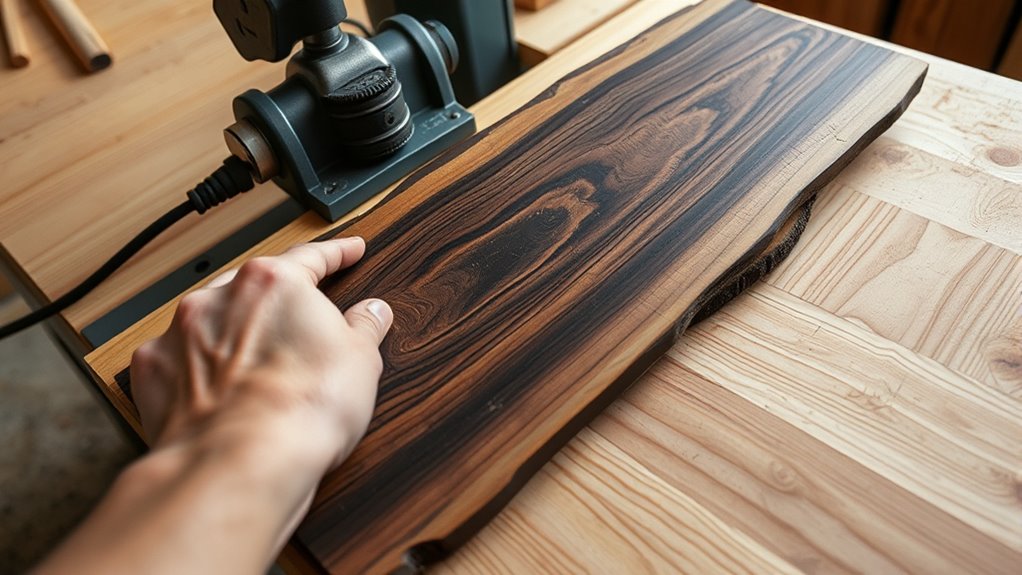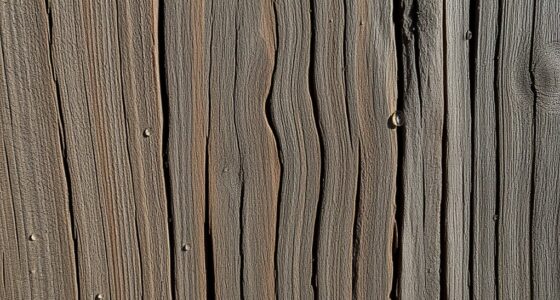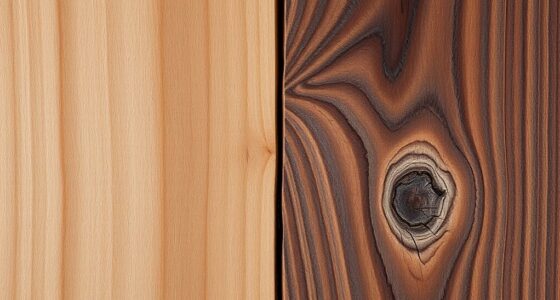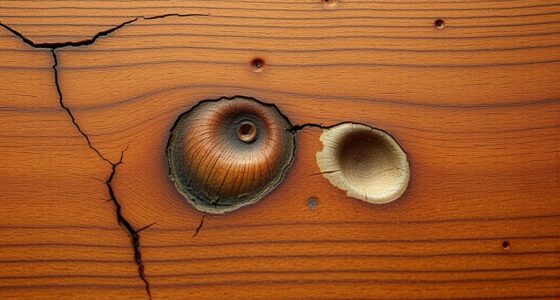When adapting plans for different wood types, consider their density, grain, and moisture content. Softwoods like pine are easier to cut and faster to work with, so you can speed up processes, while hardwoods like oak require slower speeds and sharper tools to prevent tearout. Adjust joints, finishes, and structural supports to match each wood’s properties. Understanding these differences helps guarantee your project turns out strong and beautiful, and there’s more to explore for perfect results.
Key Takeaways
- Adjust cutting speeds, feed rates, and blade types based on wood hardness and grain to prevent tearout or damage.
- Select appropriate jointing and fastening techniques suited to the wood’s density and workability.
- Modify finishing methods and products to match wood porosity and surface absorption characteristics.
- Plan for wood movement by choosing stable species and incorporating expansion gaps or floating panels.
- Consider durability and environmental resistance, selecting species and treatments suitable for the intended use and conditions.
Understanding the Basic Differences Between Softwoods and Hardwoods
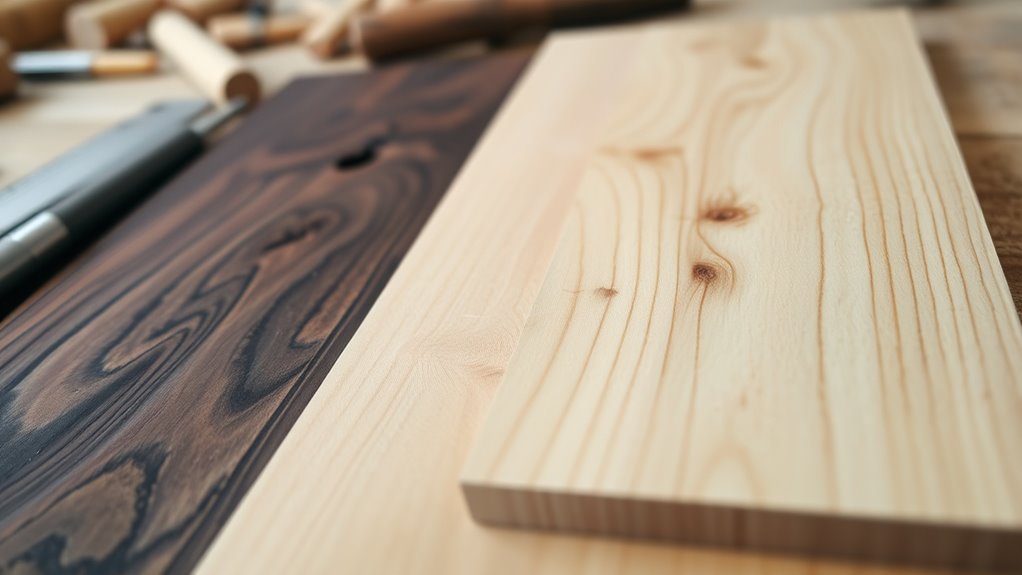
Understanding the basic differences between softwoods and hardwoods is essential when selecting the right wood for your project. Hardwoods come from angiosperm trees, which are mostly deciduous and shed their leaves annually. In contrast, softwoods come from gymnosperm trees like conifers, which keep their needles year-round. Softwoods tend to grow faster, making them more abundant and affordable, while hardwoods grow more slowly, resulting in denser, stronger, and more durable wood. Visually, hardwoods usually have darker colors and more pronounced grain patterns, whereas softwoods are lighter with softer, less distinct grain. Hardwoods are generally heavier and harder, making them suitable for furniture and flooring, while softwoods are lighter and often used in construction framing. Additionally, growth rate significantly influences the availability and cost of each type. Recognizing the wood density helps in determining the appropriate application and durability of the material. Exploring wood characteristics such as grain structure and moisture content can further assist in selecting the most suitable wood for your project. A good understanding of grain pattern can also influence the aesthetic outcome of your woodworking. Being aware of the moisture content is also crucial, as it affects the wood’s stability and performance over time.
Selecting Suitable Wood Types for Your Project Goals
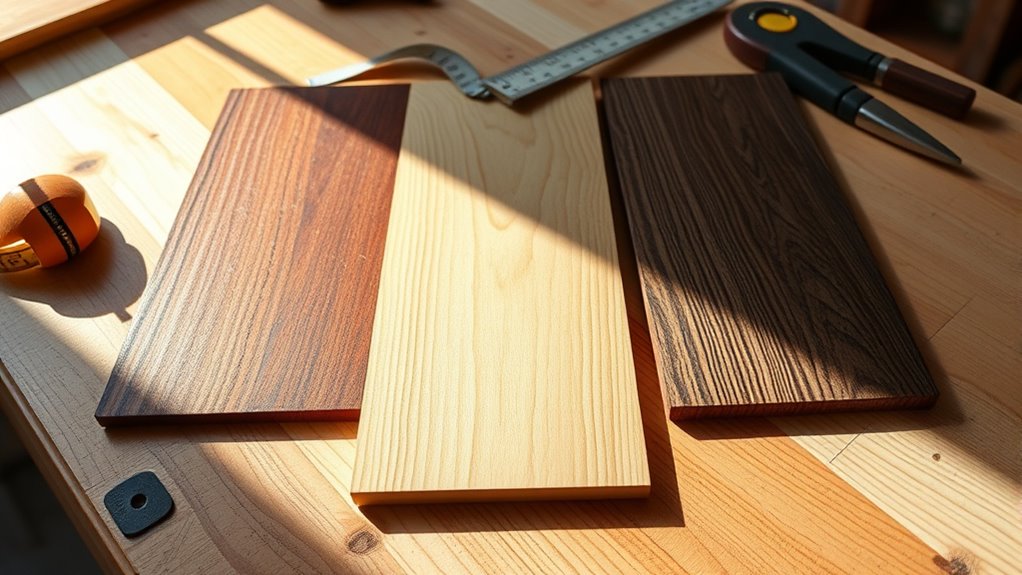
Choosing the right wood type for your project depends on your specific goals and constraints. Your budget plays a big role; softwoods like pine, spruce, and fir are affordable and ideal for framing or structural elements, while exotic hardwoods such as Brazilian Cherry offer beauty but come at a higher cost. Availability locally can reduce expenses, making species like Southern Yellow Pine a practical choice. Durability matters too—cedar naturally resists decay and insects, perfect for outdoor use, whereas hardwoods like oak and maple excel in wear resistance for flooring. Consider the aesthetic—walnut and mahogany provide rich colors and grain patterns, while pine and cedar suit rustic styles. Workability influences your choice: softer woods are easier to shape, but harder woods yield long-lasting results. Incorporating wood properties such as moisture content and grain structure can also help determine the best fit for your project. Additionally, understanding wood treatment options can enhance the longevity and performance of your selected wood. Employing modern technology can further assist in selecting the most suitable wood type, ensuring your project meets both functional and aesthetic requirements. For example, wood grading can help you assess quality and suitability for specific applications, leading to more informed decisions. Being aware of environmental sustainability considerations can also guide you toward more eco-friendly choices. Match the wood to your project’s functional and visual needs for best results.
Adjusting Cut and Join Techniques for Softwood Characteristics
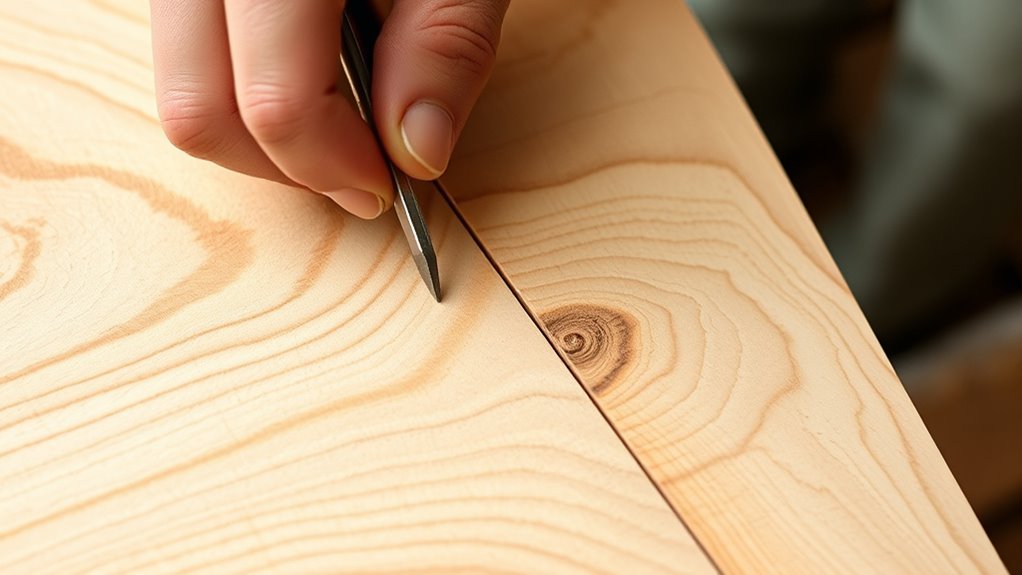
Because softwoods are easier to cut and shape, you can adapt your techniques to maximize efficiency and precision. Use sharp blades and proper saw types, like thin kerf blades, to ensure clean cuts and reduce waste.
Softwoods require less force, so you can work faster with standard tools. However, dull blades may cause tearing, so regular sharpening is essential.
Softwoods allow faster work with standard tools, but keep blades sharp to prevent tearing.
When joining, simpler methods like butt joints, dado joints, or screws work well, thanks to the wood’s lower density.
Gluing is effective, but some species may need additional coats or special adhesives due to absorbency.
For finishing, smooth the surface with sanding before applying paint or stain.
These adjustments help you take full advantage of softwood’s workability, ensuring quality results with less effort.
Planning for Durability and Environmental Resistance
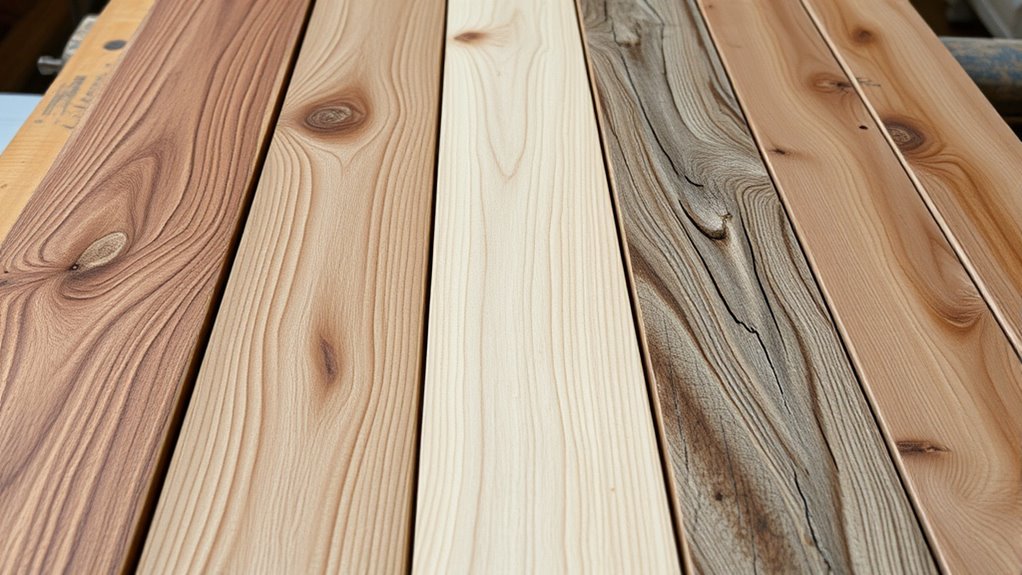
To guarantee your wood projects stand the test of time and environmental conditions, you need to plan carefully for durability and resistance. First, identify the wood’s durability class—Very Durable, Durable, Moderately Durable, or Non-Durable—and select species suited for the environment. Ensure compliance with safety standards when selecting and installing your wood, as proper safety regulations help protect your project and environment. Heartwood offers higher natural resistance than sapwood, especially in old-growth timber. For outdoor or high-moisture settings, choose woods like White Oak or Hickory, which have dense fibers and high hardness ratings, improving impact and decay resistance. Using preservative treatments and ensuring proper design details—like elevation and ventilation—can further enhance longevity. Additionally, sustainable forestry practices can help ensure the wood remains a renewable resource for future projects. Properly selecting wood with natural resistance can significantly reduce maintenance needs and costs over time. Selecting species with natural resistance reduces maintenance needs and supports sustainability. Tailoring your wood choice to environmental demands ensures your project remains durable, functional, and visually appealing over time. Moreover, understanding and utilizing wood treatment methods can further protect your projects against the elements and pests.
Modifying Designs to Accommodate Grain and Appearance Variations
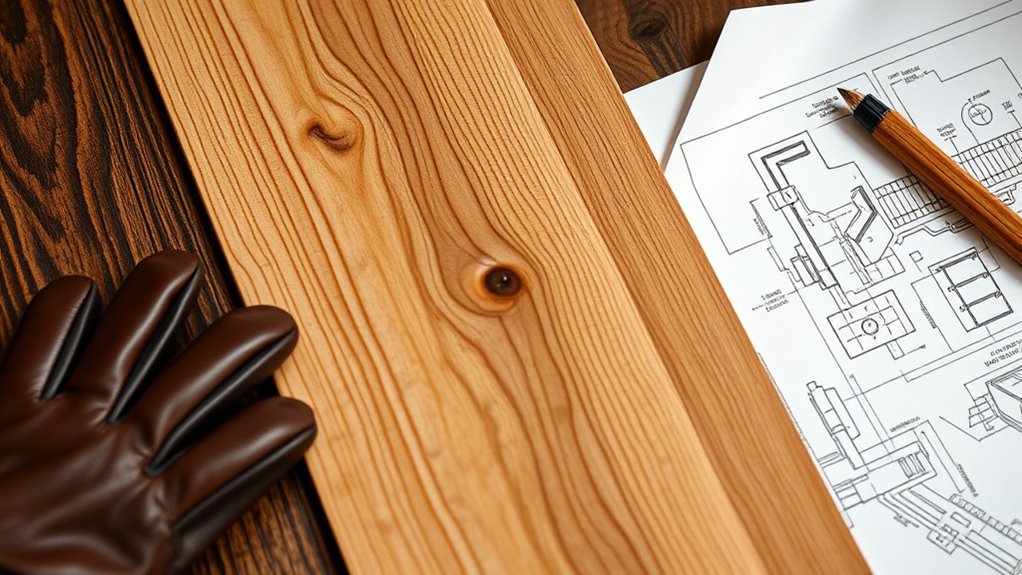
Understanding how grain and appearance variations influence your woodworking projects allows you to design with both function and aesthetics in mind. Straight grain woods like maple and cherry provide a uniform look, making cuts straightforward and finishing smooth.
Curly or figured grains, such as in curly maple or quilted mahogany, add visual interest; aligning cuts to highlight these patterns enhances the overall design. Irregular grains require careful blade angles and slower speeds to prevent tearout, while emphasizing natural patterns can create striking focal points.
For more complex grains like interlocked or spiral types, consider strategic placement of joints and veneers to avoid weaknesses. Finishes should be chosen to accentuate the grain’s depth and character, ensuring the final piece showcases its natural beauty effectively.
Tool and Equipment Adjustments for Different Density and Hardness
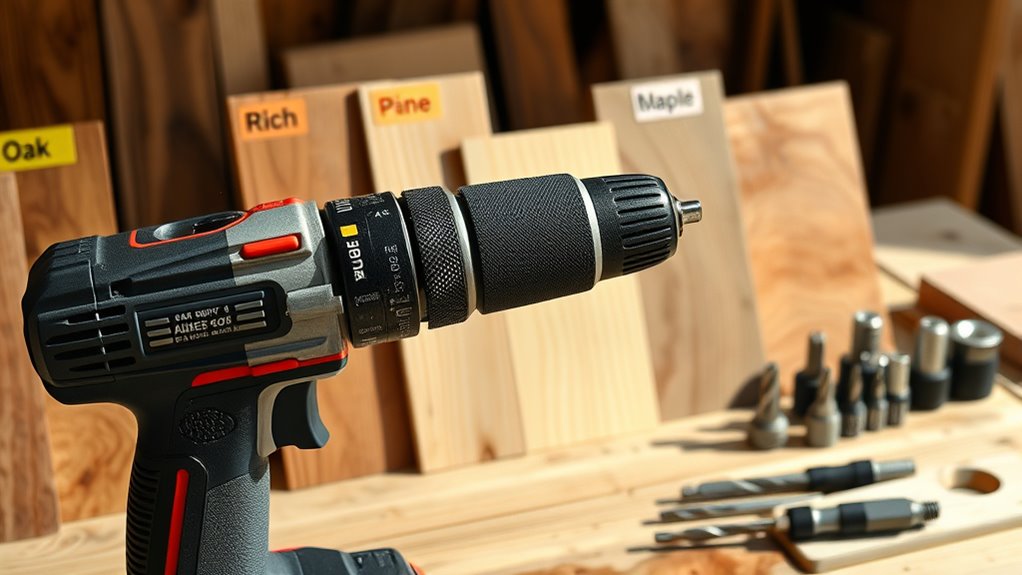
Adjusting your tools and equipment to match the density and hardness of your wood guarantees cleaner cuts and longer tool life. Denser woods like Osage orange or Ironwood require tools that can withstand higher stress, often needing carbide-tipped or coated bits to resist wear. Kia Tuning options such as performance upgrades can be analogous to selecting the right tools for tougher woods, ensuring optimal results. Softer woods such as cedar or pine cut more easily but demand sharper blades and finer teeth to prevent splintering. Tool power, feed rates, and spindle speeds should be calibrated accordingly—slower speeds and reduced feed for hard woods, faster for softwoods. Proper tooling setup includes secure clamping, especially for tougher materials, to prevent workpiece movement. Using the right cutting angles and coatings minimizes heat, friction, and premature tool failure, ensuring a smooth, efficient machining process tailored to your specific wood type. Additionally, understanding the sound vibrations involved in cutting different woods can help in selecting tools that reduce noise and vibration, leading to a safer and more comfortable working environment. Incorporating advanced machine learning algorithms can assist in predicting optimal settings based on wood type and tool wear, further optimizing the process.
Managing Wood Movement and Stability During Drying and Use
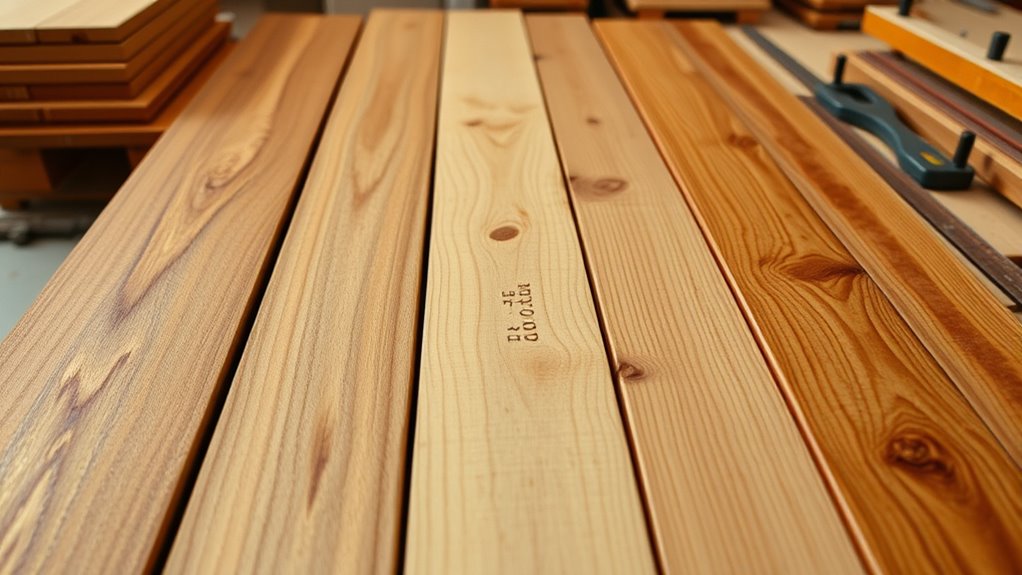
Wood movement occurs primarily along three axes—radial, tangential, and longitudinal—that influence how your material responds to changes in moisture. Tangential movement is the largest, averaging about 8%, causing wood to cup or warp. Radial movement is about 4%, leading to less distortion. Longitudinal movement is minimal, around 0.01%, so it’s less of a concern.
To manage this, select stable species like mahogany or teak, and opt for quartersawn cuts, which minimize warping. Proper drying—air drying followed by kiln drying—and acclimating wood to your environment help reduce ongoing movement. Understanding exponential growth in material properties can further optimize your design for long-term stability.
Incorporating design features like expansion gaps and floating panels allows wood to expand and contract naturally. Monitoring moisture content guarantees your wood remains stable during use, preventing future structural or aesthetic issues. Being aware of wood species with low movement tendencies can also significantly improve stability and longevity of your project.
Implementing Finishing and Surface Preparation Strategies
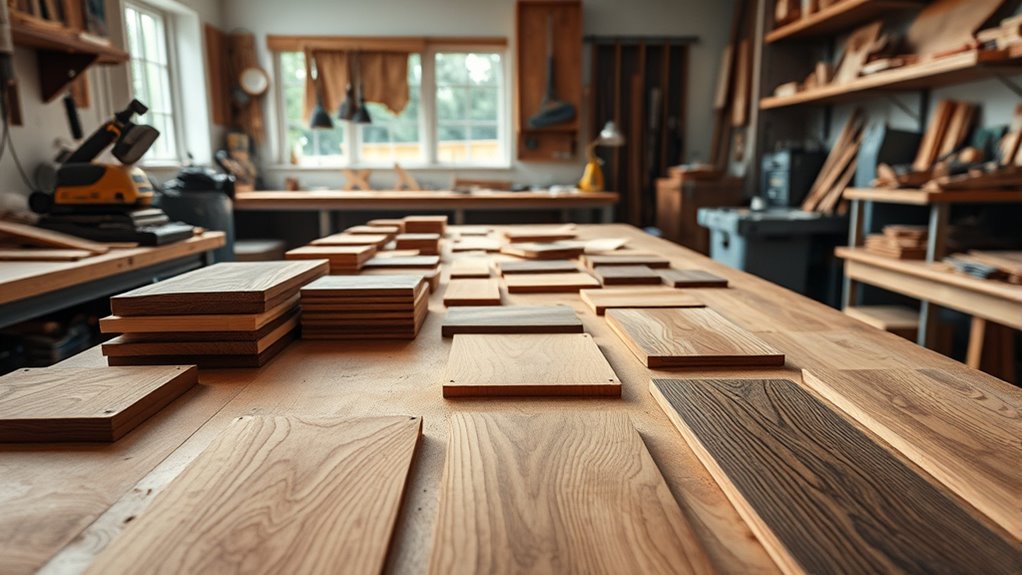
Implementing effective finishing and surface preparation strategies is essential to achieving a professional and durable wood project. Start by sanding with progressively finer grits to create a smooth surface, and clean thoroughly to remove dust and oils.
For softwoods or blotchy woods, apply a conditioner or sealer to ensure even stain absorption. When applying finishes, choose methods like brushing, spraying, or wiping based on your project’s complexity. Use appropriate brushes—natural bristles for oil-based and synthetic for water-based finishes—to improve control.
Adjust your approach depending on the wood type: hardwoods may need longer drying times, while porous woods require multiple thin coats. Proper preparation and finishing techniques guarantee your project looks great and lasts longer, regardless of the wood species.
Considering Sustainability and Material Availability in Planning
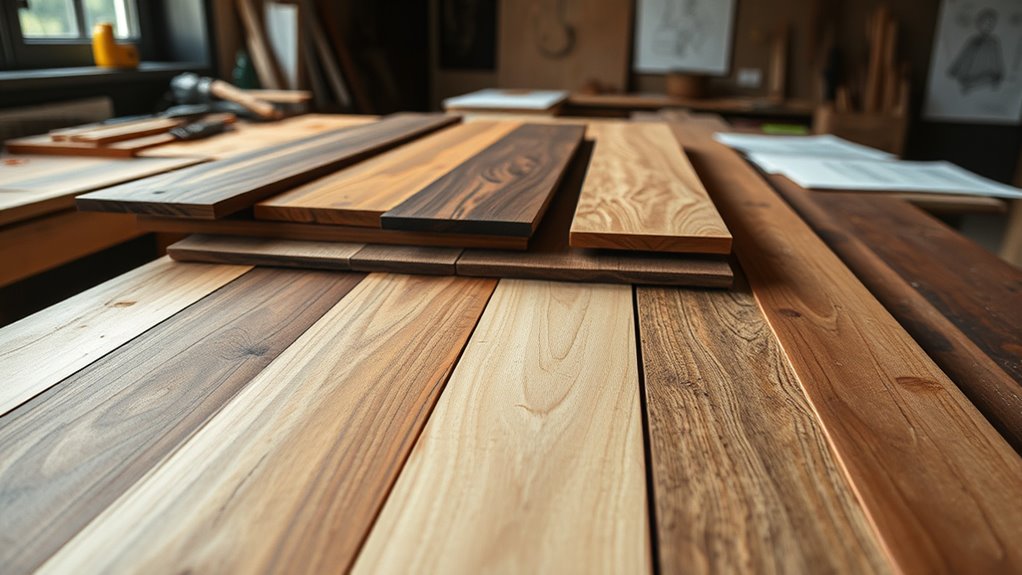
When planning your woodworking project, considering sustainability and material availability can make a significant difference. Choose wood certified by organizations like FSC to ensure ethical harvesting and sustainable forest management.
Reclaimed lumber from old buildings or furniture helps reduce waste and minimizes the need for new logging. Incorporate urban forestry wood from trees removed due to disease or storm damage to promote responsible land use.
Sourcing locally cuts transportation emissions and supports nearby economies. Be sure to verify the safety and treatment of reclaimed wood to avoid health hazards and ensure durability.
Plan your cuts carefully to maximize material use and repurpose offcuts creatively. Embracing these practices helps you create environmentally responsible projects while maintaining quality and sustainability.
Frequently Asked Questions
How Can I Identify Wood Grain Patterns During Plan Preparation?
When identifying wood grain patterns during plan preparation, you should examine the surface under good light, using a magnifying glass if needed. Run your hand lightly over the surface to feel texture differences, and moisten or apply oil to enhance contrast.
Look closely at the endgrain to see the cellular structure, pores, and rays. Recognizing the sawing method—flat, quarter, or rift—helps you predict and identify the grain pattern accurately.
What Tools Are Best Suited for Machining Dense Hardwoods?
You’re about to tackle dense hardwoods, and only the best tools will do! Carbide tools are your superheroes—ultra-durable, heat-resistant, and capable of slicing through the toughest woods like butter.
Spiral router bits and ball nose end mills handle intricate designs, while straight fluted bits make clean, straight cuts.
Use high spindle speeds, lower feed rates, and keep your tools well-maintained to turn dense hardwoods into smooth masterpieces.
How Do Moisture Levels Affect Softwood Stability in Projects?
Moisture levels directly impact softwood stability in your projects. When the moisture content is above the equilibrium, the wood absorbs moisture and swells, causing warping or cupping.
If it’s below, the wood shrinks, leading to cracks or splits. To keep your project stable, you need to measure the moisture content precisely and make certain it matches the environment’s humidity.
This helps prevent long-term deformation and ensures durability.
What Finishing Techniques Optimize Appearance on Knotty Pine?
To optimize your knotty pine’s appearance, start by using a wood conditioner for an even stain. Lightly sand the surface, then apply water-based stain with smooth, even strokes.
Follow with clear coats like varnish or Danish oil to deepen the finish and add protection. Multiple coats, with light sanding in between, will give a smooth, durable, and attractive look, highlighting the natural knots and grain.
How Do I Select Sustainable Wood Options for Large Projects?
When selecting sustainable wood for large projects, you should prioritize FSC-certified options to guarantee responsible harvesting.
Choose fast-growing species like Pine, Douglas fir, or Slash pine, which support quicker regeneration.
Opt for locally sourced wood to reduce transportation emissions and support regional economies.
Consider durability and natural decay resistance to minimize chemical treatments.
Using engineered products and recycled materials can further enhance sustainability and maximize resource efficiency in your project.
Conclusion
By understanding the differences, selecting wisely, adjusting techniques, and planning carefully, you guarantee your project’s success. You adapt your approach to the wood’s characteristics, accommodate its grain and appearance, and manage its movement and stability. You consider durability, finish, and sustainability, all while honing your skills and refining your methods. Embrace these strategies, stay flexible, and let your craftsmanship shine through in every detail. Ultimately, your careful planning transforms raw material into a masterpiece.
